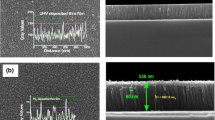Abstract
Electric quadrupole interactions were studied in pure and Mn-doped powder samples and thin films of SnO2 using perturbed γγ angular correlation spectroscopy (PAC). The powder samples were prepared by Sol gel method and the thin film were prepared on the Si (100) substrate by sputtering technique using Sn in the oxygen atmosphere. The samples were characterized by x-ray diffraction, energy dispersive spectroscopy and scanning electron microscopy. The thickness of the film was 100 nm. The average particle size of the SnO2 powder samples was determined to be smaller than 60 nm. The radioactive 111In and 181Hf tracers were introduced in the powder samples during the sol gel chemical process. Radioactive 111In was implanted on the SnO2 thin films using the University of Bonn ion implanter (BONIS). PAC measurements were carried out in a four BaF2 detector spectrometer in the temperature range of 77–973 K for samples annealed at different temperatures. The PAC results for both nuclear probes show the presence of two electric quadrupole interactions. The major fractions in both cases correspond to the substitutional sites in the rutile phase of SnO2. The results are compared with previous PAC measurements.
Similar content being viewed by others
References
Ramos, J.M., et al.: Hyperfine Interact. 197, 239 (2010)
Bibiloni, A.G. et al.: Phys. Rev. B 38, 20 (1988)
Desimoni, J., et al.: Hyperfine Interact. 34, 271 (1987)
Moreno, M.S., et al.: Hyperfine Interact. 62, 353 (1990)
Coey, J.M.D.: New J. Phys. 12, 053025 (2010)
Mach, R., Mueller, G.O.: J. Crystal Growth 86, 866 (1988)
Kiliç, Ç., Zunger, A.: Phys. Rev. Lett. 88, 095501 (2002)
Ogale, S.B., et al.: Phys. Rev. Lett. 91, 077205 (2003)
Kimura, H., et al.: Appl. Phys. Lett. 80, 94 (2002)
Gopinadhan, K., et al.: J. Appl. Phys. 102, 113513 (2007)
Hong, N.H., et al.: J. Phys. Condens. Matter 17, 1697 (2005)
Mathew, X., et al.: J. Appl. Phys. 99, 08M101 (2006)
Tian, Z.M., et al.: J. Alloys Compd. 466, 26 (2008)
Yanes, A.C., et al.: Nanot. 19, 295707 (2008)
Zakrzewska, K.: Thin Solid Films 391, 229 (2001)
Patterson, A.L.: Phys. Rev. 56, 978 (1939)
Author information
Authors and Affiliations
Corresponding author
Rights and permissions
About this article
Cite this article
Ramos, J.M., Martucci, T., Carbonari, A.W. et al. Electric field gradient in nanostructured SnO2 studied by means of PAC spectroscopy using 111Cd or 181Ta as probe nuclei. Hyperfine Interact 221, 129–136 (2013). https://doi.org/10.1007/s10751-012-0704-6
Published:
Issue Date:
DOI: https://doi.org/10.1007/s10751-012-0704-6




